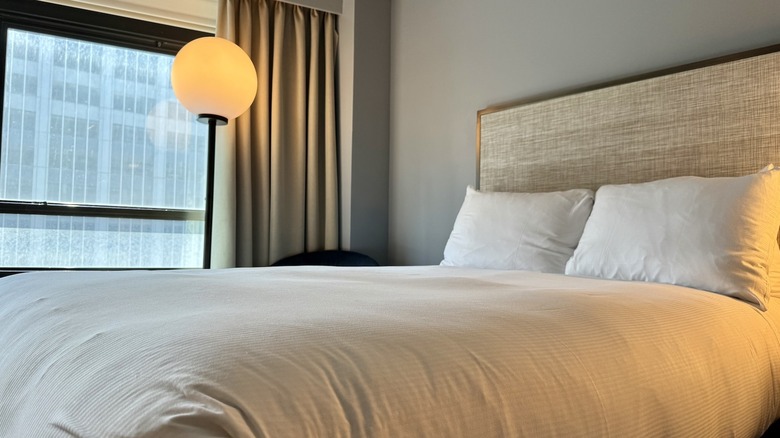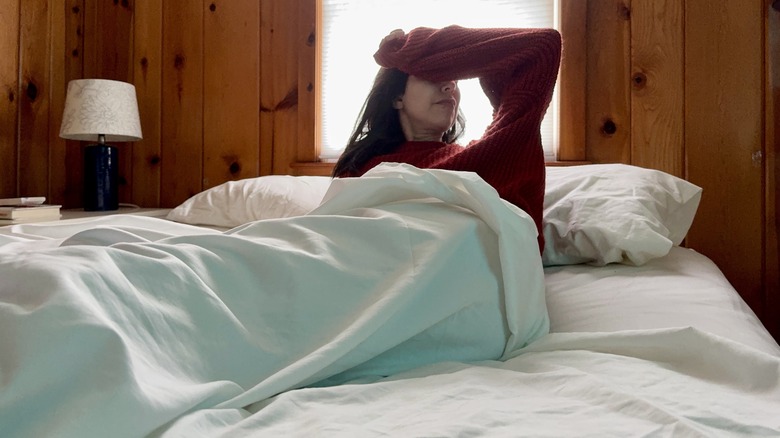We Tried This Easy Muscle Hack To Fall Asleep In No Time. Here's How It Went
If you're anything like me, sleep is an ongoing battle. Some nights, it takes me anywhere from an agonizing 30 to 45 minutes to drift off into a peaceful slumber. Naturally, I'm always on the hunt for new science-backed techniques that may help accelerate my sleep onset latency, which is how long it takes me to fall asleep. By progressively tweaking my bedtime routine, the hope is that one day I'll have crafted a tried-and-true recipe for sleep that may make life easier for others sharing in the struggle.
One purported sleep-enhancing technique — as outlined in a 2021 study published in Evidence-Based Complementary and Alternative Medicine — is a muscle hack known as progressive muscle relaxation (PMR). The creation of the technique, which first emerged in the 1920s, is credited to Edmund Jacobson. It involves the progressive tensing and releasing of muscle groups throughout the body to relieve stress and induce a state of physiological relaxation.
To walk me through the technique step by step, I chose yoga teacher Lucas Rockwood on the YOGABODY YouTube channel. The 20-minute technique involves lying flat on your back with hands at your sides and palms open towards the sky. Starting from the feet and moving up, you tense each muscle group on an inhale, then hold and release the muscles on an exhale. Rockwood also incorporates a visualization component, instructing viewers to picture a ball of light moving up the body as they go. Time to see if I've finally found the hack I've been looking for.
How I monitored my sleep while traveling
This was a particularly interesting time for me to be trying out this technique because I was traveling between time zones for the duration of the experiment. My two-week trip had me going from hotel rooms to relative's homes in different states, and as any of us can attest to, sleeping in a different bed than your own can make sleep even more challenging.
Using my own personal FitBit Inspire 3 sleep-tracking watch, I took note of what time I climbed into bed each night and began the exercise as well as what time it was once I completed it. I then checked my sleep data the next morning to see at what time I had fallen asleep. For comparison, I also tracked my sleep on nights when I didn't implement progressive muscle relaxation, which is how I initially kicked off the experiment.
The first night, it took me 16 minutes to fall asleep. Even with the help of a relaxing pre-bedtime shower, it took me a miserable 39 minutes to fall asleep the second night. As you can probably imagine, by this point I was more than ready to try out this muscle hack and see if I could improve upon my nearly 40-minute sleep onset latency time from the night before.
I fell asleep faster when I modified the muscle hack
The first night I gave progressive muscle relaxation a go, I'll admit I was feeling a bit impatient. As someone who spent months working on sitting still to meditate for just a mere five minutes, 20 minutes is a long time to lay still and focus on your body and breath. That first night proved unsuccessful, with my FitBit watch telling me that it had taken almost 45 minutes for me to fall asleep. In hindsight, I may have been clenching my muscles too tightly during the exercise. While we want to create tension, we don't want to do so to the point of discomfort.
Over the next few nights, I made some modifications to the exercise that produced more fruitful results. First and foremost, visualizations have never done much for me. I'm more into breathwork than I am into picturing myself wandering through a peaceful meadow. Therefore, I ditched the ball of light visualization and started focusing more on the breathing portion of the exercise. Specifically, I implemented what's known as the 4-7-8 breathing technique, which has been said to put the body into a state of relaxation. The technique involves inhaling for four seconds, holding your breath for seven seconds, and exhaling forcefully through the mouth for a count of eight seconds. The first night I did this in tandem with PMR, my sleep latency time dropped to 14 minutes — not bad!
Another helpful modification I made to this sleep hack
In addition to using the 4-7-8 breathing technique periodically throughout the exercise, shortening the duration of the exercise from 20 minutes to 10 minutes also seemed to help. I noticed that when I tried to hang in there for the full 20 minutes, I began concentrating too hard and any feelings of relaxation achieved went right out the window. While you'll find many scientific studies implementing 20-minute sessions of progressive muscle relaxation, "Behavioral Treatments for Sleep Disorders" outlines how some experts suggest tensing each muscle group for varying amounts of time, such as anywhere between five and 15 seconds (via ScienceDirect). Practitioners may also encourage different durations of relaxation time between the activation of each muscle group, meaning that the entirety of the technique can take a person ten minutes at minimum or as much as 30 minutes to complete. For me, ten minutes seemed to be the sweet spot.
While my sleep latency time continued to hover around 15 minutes on nights when I engaged in progressive muscle relaxation, there were a few notable exceptions. Some nights, the muscle hack was simply no match for a lumpy mattress or the effects of jet lag. While there's no guarantee, PMR might be a technique worth keeping in your back pocket the next time you're having trouble falling asleep — even better if you're in the comfort of your own bed.



